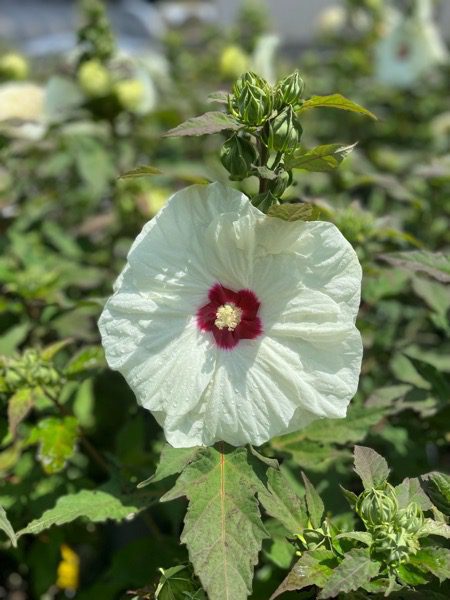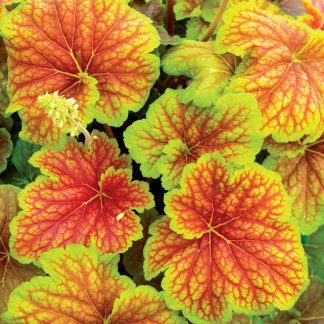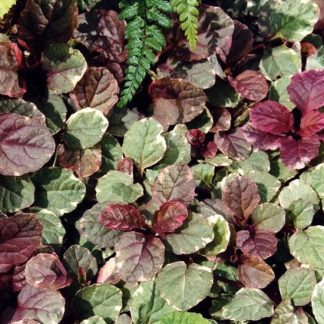Description
Hibiscus ‘French Vanilla’: A Creamy Twist on Hardy Hibiscus
Hibiscus ‘French Vanilla’ brings something fresh to the world of hardy hibiscus. While many varieties boast bright reds or bold pinks, this plant offers soft, creamy yellow blooms with a glowing red eye. The effect is gentle but still dramatic, perfect for gardeners who want color that feels warm and welcoming rather than intense.
In this guide, we explore everything that makes French Vanilla special — from its blooms and foliage to its care needs, planting tips, and creative ways to showcase it in your garden. By the end, you will see why this hibiscus has become a favorite for those who want both beauty and reliability in one plant.
A Unique Color Palette
French Vanilla stands apart from other hardy hibiscus varieties. Its flowers are large, often reaching eight inches across, but instead of bright tropical colors, they feature soft buttery-yellow petals. At the center, a deep burgundy eye radiates outward, creating striking contrast without overwhelming the delicate hue of the petals.
This unusual color combination works beautifully in many garden designs. It pairs well with soft blues, purples, and greens, making it easy to mix with perennials and shrubs. The blooms feel warm and sunny, perfect for brightening summer borders or patio containers.
Growth Habit and Plant Form
French Vanilla forms a compact, bushy mound, typically reaching three to four feet tall and wide at maturity. The foliage is lush green, creating a clean backdrop that lets the pale flowers shine. Its size makes it ideal for smaller gardens, cottage borders, or as a standout feature in mixed beds.
Like other hardy hibiscus, French Vanilla emerges late in spring. This can surprise new gardeners, who sometimes think the plant didn’t survive winter. But patience pays off — by midsummer, the plant is covered in buds, and flowering begins in a spectacular wave.
Best Location for Planting
French Vanilla thrives in full sun. The more sunlight it receives, the more flowers it will produce, and the richer its colors will appear. Aim for six to eight hours of direct sun daily.
It prefers moist, well-drained soil that is rich in organic matter. If your soil is heavy clay, mix in compost or plant in raised beds to prevent waterlogging. Consistent moisture is key — hibiscus loves water but does not like “wet feet,” which can cause root problems.
Air circulation also matters. Planting in a spot with good airflow reduces the chance of mildew and leaf spot, especially in humid climates.
Planting Steps for Success
- Pick the right time – Late spring or early summer is ideal. Wait until the soil is warm and frost danger has passed.
- Prepare the soil – Loosen the planting area and enrich with compost or organic matter.
- Dig a proper hole – Make the hole twice as wide as the root ball but no deeper.
- Set the plant – Place the root ball so the crown is level with the soil surface.
- Backfill and firm – Fill in with soil, press gently to remove air pockets, and water thoroughly.
- Mulch around the base – A two- to three-inch layer of mulch helps retain moisture and suppress weeds.
Watering and Feeding Needs
French Vanilla loves consistent moisture, especially during flowering season. Deep waterings two to three times per week keep the soil evenly moist. Avoid letting the soil dry out completely between waterings, as this can cause buds to drop.
For feeding, apply a balanced slow-release fertilizer in spring as new growth begins. To encourage abundant blooms, you can supplement with a high-potassium fertilizer every four to six weeks during summer. Stop feeding by early fall to allow the plant to prepare for dormancy.
Pruning and Maintenance
Pruning hardy hibiscus is simple and stress-free. In late fall or early spring, cut stems back to about six inches above ground level. This clears away old growth and makes room for new shoots in spring.
Deadheading is optional. Each flower lasts only a day or two, but the plant produces new blooms continuously, so there’s always fresh color. Removing spent flowers can keep the plant looking tidy, but it isn’t necessary for ongoing bloom production.
Winter Hardiness and Care
French Vanilla is hardy in USDA zones 4–9. In winter, the top growth will die back, but the roots remain alive underground. Apply a thick layer of mulch over the root zone after the first frost to insulate the plant.
Do not be alarmed if the plant is slow to emerge in spring. Hardy hibiscus often appear weeks later than other perennials. Give it time, and it will burst into vigorous growth as temperatures rise.
Companion Plants for a Harmonious Display
French Vanilla’s soft yellow blooms pair beautifully with many other plants. Here are some ideas:
- Blue and purple perennials – Russian sage, lavender, or salvia create a soothing color contrast.
- Bold reds or pinks – Coneflowers, bee balm, or daylilies can enhance the hibiscus’s warm tones.
- Ornamental grasses – Their airy texture softens the hibiscus’s bold form and provides movement.
- Shrubs with dark foliage – Plants like ninebark or barberry highlight the pale flowers.
Use French Vanilla as a focal point in mixed borders or combine it with other hardy hibiscus varieties for a multi-colored display.
A Favorite of Pollinators
The large, open flowers attract bees, butterflies, and hummingbirds. The deep red eye serves as a nectar guide, drawing pollinators directly to the center. Planting French Vanilla supports local wildlife while adding life and movement to your garden.
Container Growing Tips
French Vanilla adapts well to large pots and containers. Choose a container at least 18–20 inches wide and deep. Use a high-quality potting mix with good drainage. Because pots dry out faster than garden beds, water more often during hot weather.
Regular feeding is also important for container-grown hibiscus. Use a balanced liquid fertilizer every two to three weeks during active growth. In colder zones, containers can be overwintered by moving them to a sheltered location or insulating the pot.
Pests and Common Problems
While hardy hibiscus are generally trouble-free, a few pests and diseases may appear:
- Aphids – Can cluster on new growth; wash them off with water or use insecticidal soap.
- Japanese beetles – May chew leaves and flowers; handpick or use traps placed away from plants.
- Leaf spot or powdery mildew – Common in humid conditions; ensure good air circulation and avoid overhead watering.
These issues rarely threaten the plant’s health if addressed early.
Propagation for More Plants
You can propagate French Vanilla by division or cuttings. In spring, divide mature clumps by digging up the root mass and separating it into sections. For cuttings, take softwood cuttings in early summer and root them in moist soil or water. This is an easy way to expand your collection or share plants with friends.
Seasonal Highlights
- Spring – Slow emergence, fresh green leaves begin to appear.
- Summer – Peak bloom season, with creamy yellow flowers glowing in the sun.
- Fall – Blooms taper off; foliage provides a lush backdrop to autumn colors.
- Winter – Dormant phase; mulch protects roots until next growing season.
Why Gardeners Love French Vanilla
French Vanilla offers something rare: a hardy hibiscus with a warm, buttery color palette. Most hardy hibiscus varieties lean toward reds, pinks, or whites, so this one fills a unique niche in garden design. Its compact size and steady bloom cycle make it perfect for gardeners who want impact without overwhelming their space.
It also combines beauty with reliability. Once planted, it returns every year, often bigger and better than before. The blooms are bold yet soft, creating a soothing focal point in sunny gardens.
Perfect for Many Garden Styles
French Vanilla works in both traditional and modern gardens. In cottage gardens, it blends beautifully with mixed perennials and ornamental grasses. In contemporary landscapes, its pale blooms contrast nicely with dark foliage plants and clean architectural lines. It also shines in pollinator gardens, where its open flowers feed bees and butterflies all season long.
A Plant That Feels Like Sunshine
There’s a cheerful quality to French Vanilla hibiscus. Its blooms open wide in the heat of summer, radiating soft color and inviting pollinators to visit. Even from a distance, the flowers stand out against their green backdrop, brightening garden beds and patios alike.
A Creamy Burst of Summer Magic
Planting Hibiscus ‘French Vanilla’ is like adding a soft beam of sunshine to your landscape. It offers the drama of giant hibiscus blooms with a gentler, more soothing color palette. Whether grown in borders, containers, or as a stand-alone showpiece, this plant delivers summer-long beauty with minimal fuss.
Once established, it becomes a reliable favorite — a perennial that greets you each year with bigger blooms and brighter color. With French Vanilla in your garden, every summer feels a little sweeter, a little warmer, and a lot more magical.




